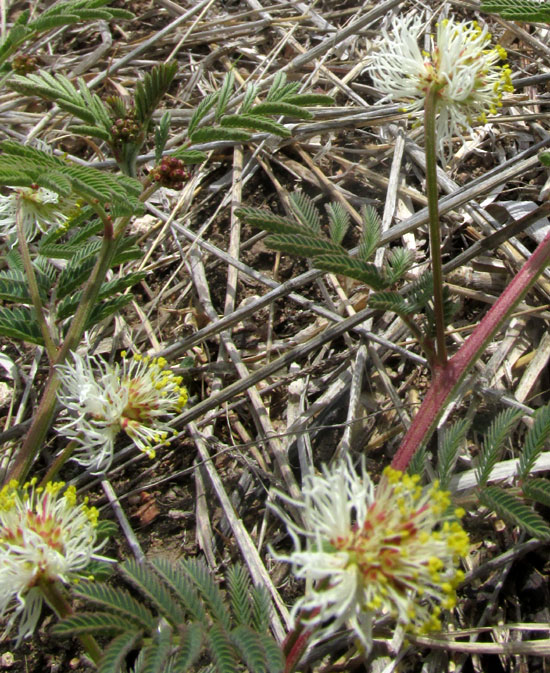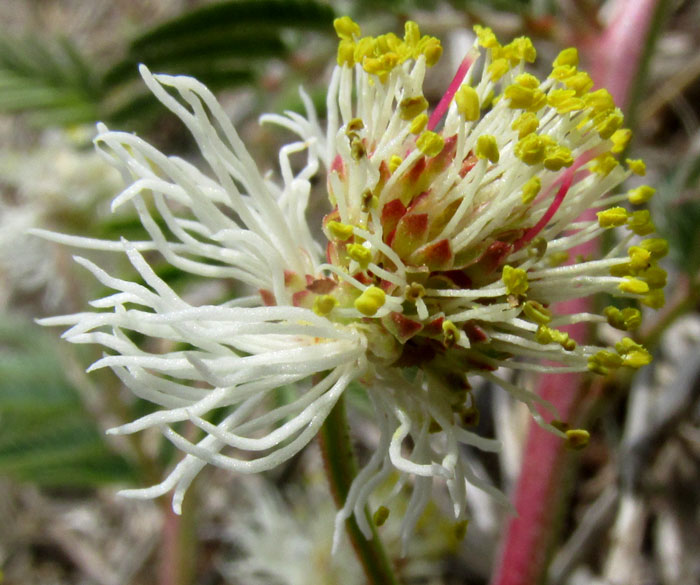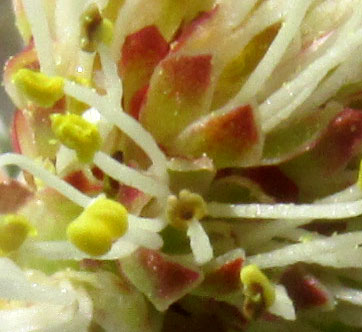Excerpts from Jim Conrad's
Naturalist Newsletter
entry dated June 25, 2022, issued from near Tequisquiapan, elevation about 1,900m (6200 ft), N20.565°, W99.890°, Querétaro state, MÉXICO
"PAINTER'S" BUNDLEFLOWER

In a grossly overgrazed field on thin, much eroded soil the above caught my eye not only because of its white flower heads but also for its manner of issuing ground-hugging stems in all directions from a central root. Up closer, things became even more interesting:

The feathery, twice-pinnate leaves and flowering heads consisting of many small flowers with numerous radiating stamens with white filaments tell us that we have a member of the Mimosa Tribe of the big Bean Family, the Fabaceae. In arid country like this we have many Mimosa Tribe members, so from the beginning an identifier notices that our plant averages six or seven pairs of the compound leaves' primary divisions, or pinnae, and each pinna is divided into 16 or so secondary divisions, or pinnules.
It's also interesting that in each flower head, or capitulum, on one side there are just white filaments, but on the other each filament bears at its tip a yellow, pollen-producing anther. The situation is seen better below:


When dealing with the Mimosa Tribe, usually it's necessary to note whether each flower in the capitulum bears 10 or fewer stamens, or more than ten. The many genera in the tribe belong either to one grouping or the other. For example, all members of the big genus Mimosa have 10 or fewer, while members of the big genus Acacia produce more than ten. At the right, especially in the flower at the upper right, it's seen that our flowers produce ten or fewer stamens surrounded by five pink-tipped calyx lobes.
Here's a better look at a leaf:

And more good field marks below:

In the above picture's upper, right corner, at the petiole's base, the sharp, narrowly triangular, pink item is a modestly short-hairy stipule. Stipule size, shape, sharpness and hairiness varies from species to species. At the picture's lower, left, note the pink, oval item looking like an inflamed blister. That's a gland, probably for producing chemicals to attract or repel insects, and its size, shape and mere presence also varies from species to species. Also, the stem is pink, faintly ribbed and somewhat short-hairy.
All these details lead us to the genus Desmanthus, of which about 24 species of mainly herbaceous perennials are recognized worldwide, mainly in the tropical and subtropical Americas. Mexico is the genus's center of diversity, being home to 14 species, of which four occur in our central upland Bajío region. To figure out which of those four we have, the main features used are those of the legume-type fruits, which our plant isn't producing yet.
However, the authoritative Flora del Bajío lists only two Desmanthus species occurring in our part of Querétaro state, and only one of the four species is described as producing several ground-hugging branches radiating from a center point, and only one species is said to be the most commonly occurring in the Bajío region, and that one species also is described as living in dry, disturbed pastures ("pastizales de tipo xerofitico pertubados") exactly like ours lives in, and that one species is DESMANTHUS PAINTERI.
Moreover, in B.L. Turner's 1950 paper, "Mexican Species of Desmanthus (Leguminosae)," mostly using features of hairiness and stated distributions, our plants "key out" to Desmanthus painteri. None of the above reasons for identifying our plant as Desmanthus painteri is conclusive, but all together they are fairly convincing.
Desmanthus painteri, being endemic just to the dry uplands of northern Mexico south to Oaxaca, at elevations of 1800-2200m (5900-7200ft), has no English name, though having been named for J.H. Painter who with others, in 1905, collected the first plant of the species eventually to be described scientifically, and that plant was found here in Querétaro, I think of it as Painter's Bundleflower.The manner by which the flowering heads of bundleflower species often, but not always, are partly composed of filaments without anthers, and partly of filaments with anthers, is worth returning to. When a flower part clearly growing where you'd expect to find a stamen consists of some kind of structure that doesn't produce pollen, it's known as a staminode. So those antherless stamens are staminodes, and among Desmanthus species they are a common occurrence, though not all Desmanthus species produce them. Also, such staminodes rarely occur in other genera, but sometimes they do. It's as if evolution is playing with the idea, and finding it hard to make up her mind.
Not much is published about this or any of the other Desmanthus species. However, one author does venture that cows are willing to eat them, which might suggest why our plants hug the ground so fervently.